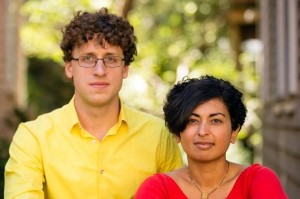In Sickness and in Health and in Science
-
-
slice.mit.edu
Filed Under
Recommended
Few couples embark on the type of radical journey that Eric Minikel SM '10, MCP '10 is traveling with his wife, Sonia Vallabh, who learned in 2011 that she has a rare genetic disease that often results in early death.

Minikel vowed to join Sonia in a race against time. He quit his job in urban planning to pursue an entirely different career path: genetics. Sonia, a lawyer, did the same. The two started studying biology and networked with science and biotech friends in Cambridge. They sought and found entry-level jobs at Mass General’s Center for Human Genetic Research. They founded a nonprofit to raise funds for clinical trials and spread the word of the rare disease.
This fall, the two will begin PhDs at Harvard Medical School.
“We’re in love, and since learning that Sonia carries a fatal genetic disease, we’ve changed everything in our lives,” says Minikel. “Next, we want to change history.”
The disease in question is fatal familial insomnia (FFI), one of the rarest of genetic prion diseases. After Sonia's mother died of it at an early age, the couple decided to get her tested for the gene, only to find out that she had it too. It strikes, on average, at age 49, and death usually follows within a year.
Given that FFI is so rare, they have not yet worked on it in their roles at MGH. “I work on neuromuscular disease genetics, and she works on Huntington's disease,” Minikel says. “Both of these have been good jumping off points to start learning the science, which we will eventually apply to FFI.”
Fortunately, at MIT’s Whitehead Institute, Professor Susan Lindquist has made FFI and prion diseases a specialty. Lindquist created the first mouse trial of the disease, which has provided Eric and Sonia with valuable data. “She was also very generous in letting Sonia sit in on her protein-folding class when Sonia was first beginning to learn biology,” adds Minikel, “and she's offered to collaborate with us in the future as we begin our PhDs.”
What about urban planning? Minikel says he uses the skill-set he acquired at MIT every day.
“My thesis was on analyzing bicycle-accident data, and I worked with my advisor, Professor Joe Ferreira, on an analysis of Massachusetts vehicle accident and insurance data. In the course of this, I learned to code in R and to manage SQL databases, both hard skills that I use every day now in the bioinformatics world. More broadly, writing my thesis taught me how to frame and answer a research question, which has been invaluable.”
“As a lifelong lover of cities,” he adds, “I was reluctant to give up the career in city planning that I had just begun. But in fact, our journey into science has proven to be an inspiring demonstration of what makes cities—and Boston in particular—amazing.”







